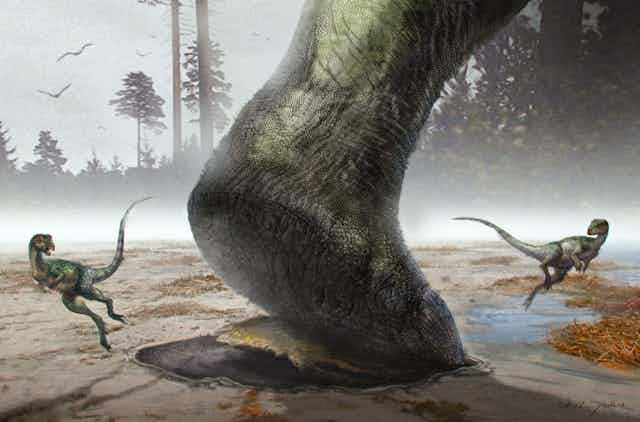How far can you trust a footprint? Dinosaur footprints are fascinating but there’s a question over how reliable they are at providing information about the palaeobiology of the creatures that made them. While certain prints have been used as evidence that dinosaurs could swim, new research now suggests that the picture is not so clear.
Fossilised footprints can show the exact shape of the feet and hands of a dinosaur. They can reveal how many toes or fingers they had, the shape of the palm or sole, and even details of the skin and scales. Some dinosaur footprints are associated with other markings formed at the same time, such as ripple marks, mud cracks, and trails of lizards, worms, and even spiders and insects skittering by. The whole dinosaur track site might look as fresh and pregnant with information as on the day it was formed, over 100 million years ago.
But there is a risk that palaeontologists can over-interpret the data gathered from footprints. They might try to identify the species of the animal that made the tracks, the speed at which it was moving, and its overall mode of locomotion. In some cases, they even develop behavioural scenarios, such as a trackway from Texas on which a herd of dinosaurs was moving along the shore, with the babies protected in the middle and the hefty adults on the outside. In the case of a large track site in Australia, there is a suggestion that a large predatory dinosaur came upon a herd of smaller dinosaurs, causing them to scatter in all directions to escape – although this has been queried by later research.
New evidence
My colleagues and I, led by Lida Xing from the China University of Geosciences in Beijing, have described some new dinosaur tracks that allow us to comment on the long-running controversy surrounding tracks supposedly showing evidence for swimming. There is no doubt that dinosaurs could swim – nearly all animals can – but the way this has been “proved” in the past has been disputed.
In earlier reports, palaeontologists sometimes pointed to unusual trackways in which perhaps only the front or hind feet were imprinted into the sediment. The argument was that the dinosaur was swimming, with its body buoyant in relatively deep water and just one set of limbs touching the bottom.
The first such example was published by renowned dinosaur hunter Roland Bird in 1944. In a famous later reconstruction, a large Brontosaurus-like animal is floating, long tail outstretched and bottom floating, hands down, paddling along the bottom, its long neck out in front. How otherwise could you get a track of hands-only prints, unless the animal was some sort of acrobat, walking on its hands? Since then, further tracks of swimming dinosaurs have been reported from Spain, the UK, Morocco, and Mexico.

The new trackways come from Gansu Province in northern China, and they consist of feet-only tracks, with no hand prints at all. Again, it is unlikely the animal was balancing on its hind legs only, and so swimming might have seemed the obvious interpretation. The tracks come from the Lower Cretaceous period, over 120 million years ago, and they are roughly circular with a clear set of four or five claw marks at the front. These prints are matched perfectly by the feet of medium-sized sauropod dinosaurs, the massive long-necked, plant-eating dinosaurs such as Brontosaurus and Titanosaurus.
But how could only the prints of the hind feet be preserved if the dinosaurs weren’t swimming (or balancing on their back legs)? It turns out that these dinosaurs, and perhaps many of the others that occur as incomplete, front-only or back-only prints, were actually walking but their prints were unequally preserved. So it comes down to geology and preservation rather than biology and behaviour.
In fact, the new Chinese prints are the same as in more usual tracks consisting of all four feet, but here the hand prints have not been preserved. If they had been swimming, with the hind-legs dangling down, some of the footprints would be scratch marks, as the foot scrabbled backwards.
Missing footprints
The tracks are well preserved, but there is evidence the animals were walking on soft sand. They pressed down because of their weight and the claws dug deeper so they could gain purchase in the sediment. Most of the animal’s weight was towards the rear and so the hind feet pressed deeper. The front feet did not apply enough pressure to make a lasting mark.
The nature of footprints can vary hugely depending on the grain size of the sediment and its water content. At a certain composition, footprints might be impressed because they exert greater pressure because the body mass is concentrated over the hind-quarters. The pressure on the hands might have been about half of the total and, in this case, they simply did not register.
This isn’t to say that sauropods didn’t swim. But in certain cases a closer study of the details of fossil footprints and the sediments can suggest a rather less romantic idea. In the case of the Chinese specimens, and perhaps many other examples of “swimming dinosaur” footprints, the loss of hand prints is down to sedimentology, not dinosaur behaviour.

